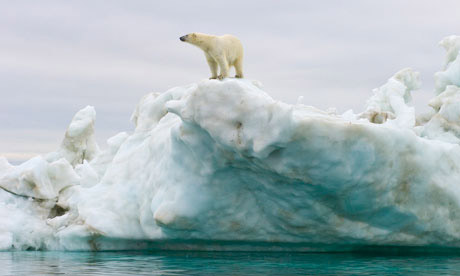|
 Since the 1970s, there has been a 40% decrease in the extent of summer sea ice. |
|
Study finds only 30% of radical loss of summer sea ice is due to natural variability in Atlantic – and it will probably get worse. The radical decline in sea ice around the Arctic is at least 70% due to human-induced climate change, according to a new study, and may even be up to 95% down to humans – rather higher than scientists had previously thought. The loss of ice around the Arctic has adverse effects on wildlife and also opens up new northern sea routes and opportunities to drill for oil and gas under the newly accessible sea bed. The reduction has been accelerating since the 1990s and many scientists believe the Arctic may become ice-free in the summers later this century, possibly as early as the late 2020s. "Since the 1970s, there's been a 40% decrease in the summer sea ice extent," said Jonny Day, a climate scientist at the National Centre for Atmospheric Science at the University of Reading, who led the latest study. "We were trying to determine how much of this was due to natural variability and therefore imply what aspect is due to man-made climate change as well." To test the ideas, Day carried out several computer-based simulations of how the climate around the Arctic might have fluctuated since 1979 without the input of greenhouse gases from human activity. He found that a climate system called the Atlantic multi-decadal oscillation (AMO) was a dominant source of variability in ice extent. The AMO is a cycle of warming and cooling in the North Atlantic that repeats every 65 to 80 years – it has been in a warming phase since the mid-1970s. Comparing the models with actual observations, Day was able to work out what contribution the natural systems had made to what researchers have observed from satellite data. "We could only attribute as much as 30% [of the Arctic ice loss] to the AMO," he said. "Which implies that the rest is due to something else, and this is most likely going to be man-made global change." Previous studies had indicated that around half of the loss was due to man-made climate change and that the other half was due to natural variability. The research is published online in the journal Environmental Research Letters. (Read by CJ Henderson. CJ Henderson is a journalist at the China Daily Website.) (Agencies) |
研究发现,北极海冰夏季大面积融化可能会进一步加剧,而这其中只有30%由大西洋的自然环境变化所造成。 根据一项最新研究,北冰洋海冰的大面积融化至少有70%都是由人类活动引起的气候变化造成,而且这一比例可能还会升至95%——比科学家之前预测的还要更高。 北极周围冰盖的融化对野生动物的影响十分不利,此外海冰的融化还将使北部海域得以开辟新的航线,有机会开采新近得以勘探的海底油气。 自上世纪90年代起北极冰盖便已开始加速融化,很多科学家都认为本世纪后期北极夏季将没有冰盖,也许这一情形在本世纪20年代末便会发生。 英国瑞丁大学国家大气科学中心气象学家约翰尼•戴是这项新研究的带头人,他说:“20世纪70年代以来,北极夏季海冰已经减少了40%。” “我们正试着确定这种情况多大程度上是由自然环境的变化造成的,从而得出哪些方面是由人为气候变化造成。” 为了验证这一想法,戴利用计算机技术,模拟了在没有人类排放温室气体的情况下,北极地区的气候自1979年以来是如何发生变化的。 他发现一个名叫大西洋多年代际震荡的系统是追溯冰层变化的一个主要来源。该系统是北大西洋以65到80年为周期的冷暖周期——根据该系统数据显示,自上世纪70年代中期以来,该地区便处于暖周期。 将该模型与实际观察对比后,戴找出了该自然系统对研究者观测卫星数据所获得结果的影响。 “我们最多只能把北极冰盖融化的30%归咎于AMO系统。”他说:“这就意味着剩下的70%都是其它原因造成的,而这些原因最有可能就是人类活动引起的全球气候变化。” 前人研究已经表明,北极冰层融化的50%是人为气候变化造成的,另一半则是由于自然环境的变化。 这一研究结果发布在《环境研究快报》杂志的网站上。 相关阅读 (中国日报网英语点津 陈丹妮 编辑:Julie) |
|
Vocabulary: attribute...to: 把……归因于;把……归咎于 |
